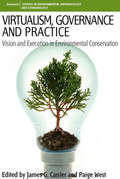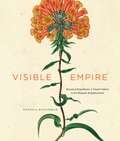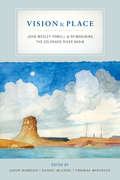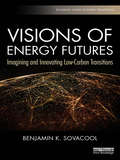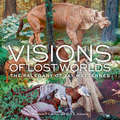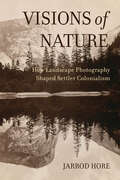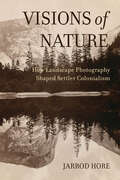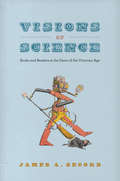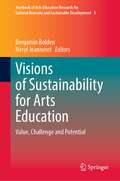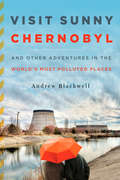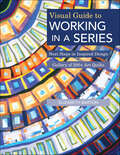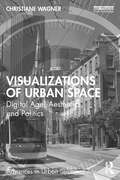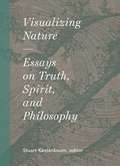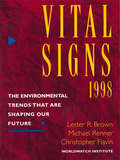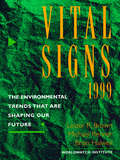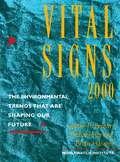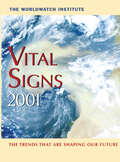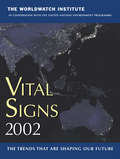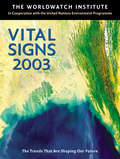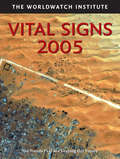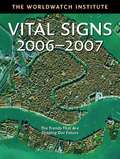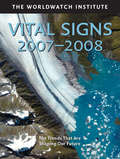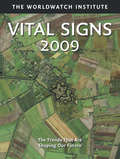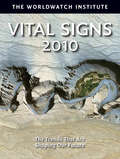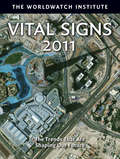- Table View
- List View
Virtualism, Governance And Practice
by Paige West James G. CarrierMany people investigating the operation of large-scale environmentalist organizations see signs of power, knowledge and governance in their policies and projects. This collection indicates that such an analysis appears to be justified from one perspective, but not from another. The chapters in this collection show that the critics, concerned with the power of these organizations to impose their policies in different parts of the world, appear justified when we look at environmentalist visions and at organizational policies and programs. However, they are much less justified when we look at the practical operation of such organizations and their ability to generate and carry out projects intended to reshape the world.
Visible Empire: Botanical Expeditions and Visual Culture in the Hispanic Enlightenment
by Daniela BleichmarBetween 1777 and 1816, botanical expeditions crisscrossed the vast Spanish empire in an ambitious project to survey the flora of much of the Americas, the Caribbean, and the Philippines. While these voyages produced written texts and compiled collections of specimens, they dedicated an overwhelming proportion of their resources and energy to the creation of visual materials. European and American naturalists and artists collaborated to manufacture a staggering total of more than 12,000 botanical illustrations. Yet these images have remained largely overlooked—until now. In this lavishly illustrated volume, Daniela Bleichmar gives this archive its due, finding in these botanical images a window into the worlds of Enlightenment science, visual culture, and empire. Through innovative interdisciplinary scholarship that bridges the histories of science, visual culture, and the Hispanic world, Bleichmar uses these images to trace two related histories: the little-known history of scientific expeditions in the Hispanic Enlightenment and the history of visual evidence in both science and administration in the early modern Spanish empire. As Bleichmar shows, in the Spanish empire visual epistemology operated not only in scientific contexts but also as part of an imperial apparatus that had a long-established tradition of deploying visual evidence for administrative purposes.
Vision and Place: John Wesley Powell and Reimagining the Colorado River Basin
by Jason Robison, Daniel McCool, and Thomas MinckleyThe Colorado River Basin’s importance cannot be overstated. Its living river system supplies water to roughly forty million people, contains Grand Canyon National Park, Bears Ears National Monument, and wide swaths of other public lands, and encompasses ancestral homelands of twenty-nine Native American tribes. John Wesley Powell, a one-armed Civil War veteran, explorer, scientist, and adept federal administrator, articulated a vision for Euro-American colonization of the "Arid Region" that has indelibly shaped the basin—a pattern that looms large not only in western history, but also in contemporary environmental and social policy. One hundred and fifty years after Powell’s epic 1869 Colorado River Exploring Expedition, this volume revisits Powell’s vision, examining its historical character and its relative influence on the Colorado River Basin’s cultural and physical landscape in modern times. In three parts, the volume unpacks Powell’s ideas on water, public lands, and Native Americans—ideas at once innovative, complex, and contradictory. With an eye toward climate change and a host of related challenges facing the basin, the volume turns to the future, reflecting on how—if at all—Powell’s legacy might inform our collective vision as we navigate a new "Great Unknown."
Visions of Energy Futures: Imagining and Innovating Low-Carbon Transitions (Routledge Studies in Energy Transitions)
by Benjamin K. SovacoolThis book examines the visions, fantasies, frames, discourses, imaginaries, and expectations associated with six state-of-the-art energy systems—nuclear power, hydrogen fuel cells, shale gas, clean coal, smart meters, and electric vehicles—playing a key role in current deliberations about low-carbon energy supply and use. Visions of Energy Futures: Imagining and Innovating Low-Carbon Transitions unveils what the future of energy systems could look like, and how their meanings are produced, often alongside moments of contestation. Theoretically, it analyzes these technological case studies with emerging concepts from various disciplines: utopianism (history of technology), symbolic convergence (communication studies), technological frames (social construction of technology), discursive coalitions (discourse analysis and linguistics), sociotechnical imaginaries (science and technology studies), and the sociology of expectations (innovation studies, future studies). It draws from these cases to create a synthetic set of dichotomies and frameworks for energy futures based on original data collected across two global epistemic communities— nuclear physicists and hydrogen engineers—and experts in Eastern Europe and the Nordic region, stakeholders in South Africa, and newspapers in the United Kingdom. This book is motivated by the premise that tackling climate change via low-carbon energy systems and practices is one of the most significant challenges of the twenty-first century, and that success will require not only new energy technologies, but also new ways of understanding language, visions, and discursive politics. The discursive creation of the energy systems of tomorrow are propagated in polity, hoping to be realized as the material fact of the future, but processed in conflicting ways with underlying tensions as to how contemporary societies ought to be ordered. This book will be essential reading for students and scholars of energy policy, energy and environment, and technology assessment.
Visions of Lost Worlds: The Paleoart of Jay Matternes
by Matthew T. Carrano Kirk R. JohnsonA lavish showcase of paleoartist Jay Matternes's spectacular murals and sketchesFor half a century, the artwork of Jay Matternes adorned the fossil halls of the Smithsonian National Museum of Natural History. These treasured Matternes murals documenting mammal evolution over the past 56 million years and dioramas showing dinosaurs from the Mesozoic Era are significant works of one of the most influential paleoartists in history. Simultaneously epic in size and scope and minutely detailed, they also provide a window into the study and interpretation of vertebrate paleontology and paleoecology. Visions of Lost Worlds presents these unparalleled works of art, and also includes the sketches and drawings Matternes prepared as he planned the murals. Known for his technical genius and eye for detail, Matternes sketched from skeletons in museum collections and added muscle, skin, and fur to bring mammals and dinosaurs from prehistory to vivid life. This book offers a close look at these works of art, a peek inside the artist's process, and an examination of the works' impact and legacy.
Visions of Nature: How Landscape Photography Shaped Settler Colonialism
by Dr. Jarrod HoreVisions of Nature revives the work of late nineteenth-century landscape photographers who shaped the environmental attitudes of settlers in the colonies of the Tasman World and in California. Despite having little association with one another, these photographers developed remarkably similar visions of nature. They rode a wave of interest in wilderness imagery and made pictures that were hung in settler drawing rooms, perused in albums, projected in theaters, and re-created on vacations. In both the American West and the Tasman World, landscape photography fed into settler belonging and produced new ways of thinking about territory and history. During this key period of settler revolution, a generation of photographers came to associate "nature" with remoteness, antiquity, and emptiness, a perspective that disguised the realities of Indigenous presence and reinforced colonial fantasies of environmental abundance. This book lifts the work of these photographers out of their provincial contexts and repositions it within a new comparative frame.
Visions of Nature: How Landscape Photography Shaped Settler Colonialism
by Dr. Jarrod HoreVisions of Nature revives the work of late nineteenth-century landscape photographers who shaped the environmental attitudes of settlers in the colonies of the Tasman World and in California. Despite having little association with one another, these photographers developed remarkably similar visions of nature. They rode a wave of interest in wilderness imagery and made pictures that were hung in settler drawing rooms, perused in albums, projected in theaters, and re-created on vacations. In both the American West and the Tasman World, landscape photography fed into settler belonging and produced new ways of thinking about territory and history. During this key period of settler revolution, a generation of photographers came to associate "nature" with remoteness, antiquity, and emptiness, a perspective that disguised the realities of Indigenous presence and reinforced colonial fantasies of environmental abundance. This book lifts the work of these photographers out of their provincial contexts and repositions it within a new comparative frame.
Visions of Science: Books and Readers at the Dawn of the Victorian Age
by James A. SecordThe first half of the nineteenth century witnessed an extraordinary transformation in British political, literary, and intellectual life. There was widespread social unrest, and debates raged regarding education, the lives of the working class, and the new industrial, machine-governed world. At the same time, modern science emerged in Europe in more or less its current form, as new disciplines and revolutionary concepts, including evolution and the vastness of geologic time, began to take shape. In Visions of Science, James A. Secord offers a new way to capture this unique moment of change. He explores seven key books—among them Charles Babbage’s Reflections on the Decline of Science, Charles Lyell’s Principles ofGeology, Mary Somerville’s Connexion of the Physical Sciences, and Thomas Carlyle’s Sartor Resartus—and shows how literature that reflects on the wider meaning of science can be revelatory when granted the kind of close reading usually reserved for fiction and poetry. These books considered the meanings of science and its place in modern life, looking to the future, coordinating and connecting the sciences, and forging knowledge that would be appropriate for the new age. Their aim was often philosophical, but Secord shows it was just as often imaginative, projective, and practical: to suggest not only how to think about the natural world but also to indicate modes of action and potential consequences in an era of unparalleled change. Visions of Science opens our eyes to how genteel ladies, working men, and the literary elite responded to these remarkable works. It reveals the importance of understanding the physical qualities of books and the key role of printers and publishers, from factories pouring out cheap compendia to fashionable publishing houses in London’s West End. Secord’s vivid account takes us to the heart of an information revolution that was to have profound consequences for the making of the modern world.
Visions of Sustainability for Arts Education: Value, Challenge and Potential (Yearbook of Arts Education Research for Cultural Diversity and Sustainable Development #3)
by Benjamin Bolden Neryl JeanneretThis book stems from the 2019 meeting of the UNESCO UNITWIN international network for Arts Education Research for Cultural Diversity and Sustainable Development. It presents scholarly, international perspectives on issues surrounding arts education and sustainability that addresses the following questions: What value can the arts add to the education of citizens of the 21st century?; What are the challenges and ways forward to realize the potential of arts education in diverse contexts? The book discusses empirical research and exemplary practices in the arts and arts education around the world, presenting sound theoretical and methodological frames and approaches. It identifies policy implications at national, regional and global levels that cut across social, economic, environmental and cultural dimensions of sustainable development.
Visit Sunny Chernobyl: And Other Adventures in the World's Most Polluted Places
by Andew BlackwellFor most of us, traveling means visiting the most beautiful places on Earth—Paris, the Taj Mahal, the Grand Canyon. It's rare to book a plane ticket to visit the lifeless moonscape of Canada's oil sand strip mines, or to seek out the Chinese city of Linfen, legendary as the most polluted in the world. But in Visit Sunny Chernobyl, Andrew Blackwell embraces a different kind of travel, taking a jaunt through the most gruesomely polluted places on Earth. From the hidden bars and convenience stores of a radioactive wilderness to the sacred but reeking waters of India, Visit Sunny Chernobyl fuses immersive first-person reporting with satire and analysis, making the case that it's time to start appreciating our planet as it is—not as we wish it would be. Irreverent and reflective, the book is a love letter to our biosphere's most tainted, most degraded ecosystems, and a measured consideration of what they mean for us. Equal parts travelogue, expose, environmental memoir, and faux guidebook, Blackwell careens through a rogue's gallery of environmental disaster areas in search of the worst the world has to offer—and approaches a deeper understanding of what's really happening to our planet in the process.
Visual Guide to Working in a Series: Next Steps in Inspired Design
by Elizabeth BartonDeepen your quilt artistry by creating quilts in a series This inspiring guide from art quilter Elizabeth Barton is for quilt artists who have mastered the basics and want to explore deeper levels of creativity and skill. Learn how making a series of quilts can help you generate more ideas, find new subtleties in favorite subjects, and build a body of work for shows. Packed with hands-on lessons and examples, this book will transform your work and enlarge your creative vision forever. • Creative exercises help you develop your own themes and techniques • Includes huge gallery of more than 200 examples from Elizabeth and other working art quilters • Explains how working in a series elevates creativity and artistic depth
Visualizations of Urban Space: Digital Age, Aesthetics, and Politics (Advances in Urban Sustainability)
by Christiane WagnerThis book explores environments where art, imagination, and creative practice meet urban spaces at the point where they connect to the digital world. It investigates relationships between urban visualizations, aesthetics, and politics in the context of new technologies, and social and urban challenges toward the Sustainable Development Goals. Responding to questions stemming from critical theory, the book focuses on an interdisciplinary actualization of technological developments and social challenges. It demonstrates how art, architecture, and design can transform culture, society, and nature through artistic and cultural achievements, integration, and new developments. The book begins with the theoretical framework of social aesthetics theories before discussing global contemporary visual culture and technological evolution. Across the 12 chapters, it looks at how architecture and design play significant roles in causing and solving complex environmental transformations in the digital turn. By fostering transdisciplinary encounters between architecture, design, visual arts, and cinematography, this book presents different theoretical approaches to how the arts’ interplay with the environment responds to the logic of the constructions of reality. This book will appeal to scholars, researchers, and upper-level students in aesthetics, philosophy, visual cultural studies, communication studies, and media studies with a particular interest in sociopolitical and environmental discussions.
Visualizing Nature: Essays on Truth, Spririt, and Philosophy
by Stuart KestenbaumVisualizing Nature brings together contemporary visionaries to share deeply personal essays on nature, ecology, sustainability, climate change, philosophy, and more. Compiled by editor and poet Stuart Kestenbaum, the contributors represent a wide range of backgrounds and experiences, each honoring nature's power to heal, inspire, guide, amaze, and strengthen.Activist Maulian Dana of the Penobscot Nation writes on the intertwining relationship of motherhood and Mother Earth. Biology professor David Haskell tells the story of the resilient bristlecone pine trees, which live to be as old as 2,100 years. Iranian scholar Alireza Taghdarreh speaks to his experience of translating Emerson's "Nature" into Farsi. A previously unpublished 1962 speech by Rachel Carson complements the collection of more than twenty essays, each inviting the reader into a quiet space of reflection with the opportunity to think deeply about how they relate to the natural world.
Vital Signs 1998 (Vital Signs)
by The Worldwatch InstituteThe new Vital Signs 1998 gives you more than 100 charts, graphs and tables that show you the worldwide trends that are changing our lives, for better and for worse. It includes the latest data on critical global trends, presented in simple but compelling graphics, along with concise, thoughtful analysis.
Vital Signs 1999 (Vital Signs)
by The Worldwatch InstituteThe global trends documented in Vital Signs 1999--from a decline in nuclear power generating capacity to the proliferation of genetically modified crops--will play a large part in determining the quality of our lives and our children's lives in the next decade.
Vital Signs 2000
by The Worldwatch InstituteThe global trends documented in Vital Signs 2000--from the rapid rise in the sales of energy-efficient compact fluorescent lamps to the worldwide overpumping of growndwater--will play a large role in determining the quality of our lives and our children's lives in the next decade.
Vital Signs 2001: The Environmental Trends That Are Shaping Our Future (Vital Signs)
by The Worldwatch InstituteThe global trends documented in Vital Signs 2001 - from the rapid increase in the use of wind power to the continued warming of the planet - will play a large role in determining the quality of our lives and our children's lives in this new century.
Vital Signs 2002 (Vital Signs)
by The Worldwatch InstituteThe 2002 edition features more than 50 key indicators of long-term trends - from the growth of fish farms and bicycle production to the increase in solar cell and Internet use.
Vital Signs 2003 (Vital Signs)
by The Worldwatch InstituteWith Vital Signs 2003, you'll have the cogent analysis you need to prepare for tomorrow's challenges.
Vital Signs 2005 (Vital Signs)
by The Worldwatch InstituteThis much-anticipated edition of Vital Signs covers 35 global trends that are shaping our future. From carbon emissions to loss of wetlands, each trend provides a brief status report on the topic plus graphs and charts that offer a visual comparison over time. Categories include Food, Economics, Transportation, Health, Governance, Energy and Climate, and Conflict and Peace.
Vital Signs 2006-2007
by The Worldwatch InstituteThis report tracks and analyzes 44 trends that are shaping our future, and includes graphs and charts to provide a visual comparison over time. Categories of trends include: Food, Agricultural Resources, Energy and Climate, Global Economy, Resource Economics, Environment, War and Conflict, Communications and Transportation, Population and Society, and Health and Disease.
Vital Signs 2007-2008 (Vital Signs)
by The Worldwatch InstituteThis report tracks and analyzes 44 trends that are shaping our future, and includes graphs and charts to provide a visual comparison over time. Categories of trends include: Food, Agricultural Resources, Energy and Climate, Global Economy, Resource Economics, Environment, Conflict and Peace, Communications and Transportation, Population and Society, and Health and Disease.
Vital Signs 2009 (Vital Signs)
by The Worldwatch InstituteThis sixteenth volume of Worldwatch's Vital Signs series makes it clear that climate change is both a growing driver of and an increasingly important motivator behind the world's leading economic, social, and environmental trends
Vital Signs 2010 (Vital Signs)
by The Worldwatch InstituteThis seventeenth edition of the Worldwatch Institute series shows that climate change continues to cast a long shadow over the world's leading economic, social, and environmental trends.
Vital Signs 2011 (Vital Signs)
by The Worldwatch InstituteThis eighteenth volume of the Worldwatch Institute series makes it clear that the Great Recession affects many of the world's leading economic, social, and environmental trends - but that the impact can be very different by country.
